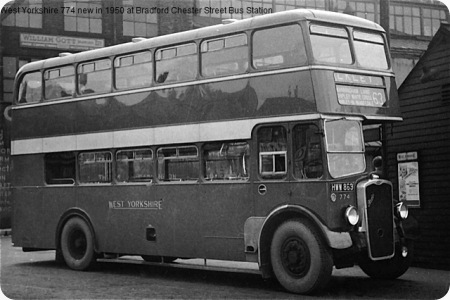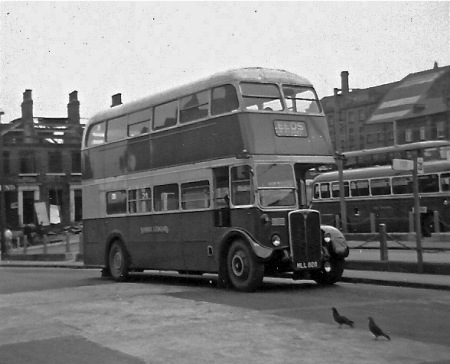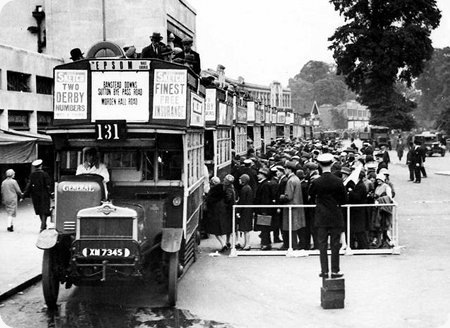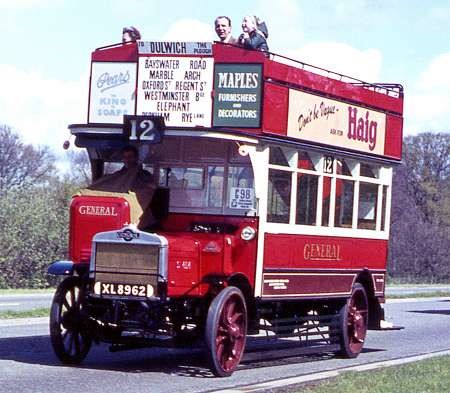Southdown – Leyland Tiger – AUF 851 – 51 (551 from 1937)
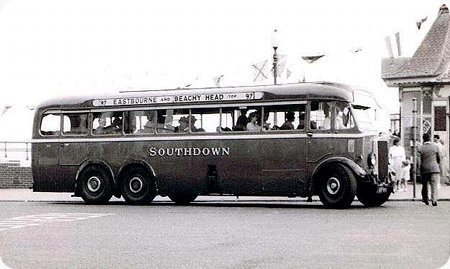
Copyright Jack Turley/Dinnages
Southdown Motors Services
1934
Leyland Tiger TS6T
Short Bros. B40C (B39C from about 1946)
Two of these impressive and handsome vehicles (51 & 52) were purchased in 1934 for the Eastbourne to Beachy Head tourist service. The local authority would only allow the service to operate with single-deckers, so Southdown decided to buy the largest single-deckers available at the time, which, by law, had to be 30 foot long six-wheelers. Long-time Leyland adherents, they settled on the fairly rare TS6T (T standing for Trailing Axle), which enabled them to carry 40 passengers on the profitable route. A further two (53 & 54) were bought in 1935, this time TS7T’s.
Originally fitted with Leyland 8.6 petrol engines, they were all fitted with 8.6 diesel engines in 1940. Despite their luxurious appearance, they were considered to be buses by Southdown, bearing the name in letters rather than ‘real writing’!
After their hard lives, they were all withdrawn from service in 1952.
The photo shows 551, in about 1950, about to depart from Eastbourne Pier and grind its way up to the top of Beachy Head. Note the driver in his summer uniform.
Photograph and Copy contributed by Chris Hebbron
29/05/11 – 17:46
What truly magnificent vehicles, and even further enhanced by the cream side destination boards. My own experience of the ascent on service 97 to Beachy Head is confined to the delightful open top Guy Arabs in the 1960s – and there’s scarcely any need to go into detail about the delightful acoustics of that journey !!
Chris Youhill
29/05/11 – 19:15
Yes, the austerity Guy Arab II’s were converted to open-top around 1950-51 and some re-engined with 6LW engines for the Devil’s Dyke/Beachy Head services. The service became 197 around that time, too. The open-toppers were used all along the South Coast, even a couple on Hayling Island. They lasted until about 1964.
Unlike the TS6T’s, the basic Guys were regarded as coaches and given ‘Southdown’ side panels in ‘real writing’!
A 1964 film, The Chalk Garden, has Hayley Mills and Deborah Kerr boarding one of them, with it pulling away.
I don’t know how extensive the rebuilding of the bodies was, but they always looked impeccable, right to the end. Southdown were a class act.
Chris Hebbron
30/05/11 – 06:25
So true Chris H, Southdown were exactly as you say – "a class act." The winning combination of high quality handsome vehicles and impeccable maintenance was perfected even further by perhaps the most dignified of all liveries in such very pleasing colours.
Chris Youhill
31/05/11 – 11:40
and what about the Harrington Cavalier coaches with only 28 seats for there road cruises.
Roger Broughton
31/05/11 – 11:58
By the late 1960s, the Devil’s Dyke service was operated with convertible ‘Queen Mary’ Leylands. At Southdown, vehicle allocation, (including when the tops were to be removed), was decided by the Engineering Department rather than the Traffic Department, unlike other companies I knew, a practice that didn’t always contribute to efficient traffic management. Their policy on which style of company name to apply to any particular vehicle or type, was inconsistent.
I am well aware of Southdown’s reputation amongst some enthusiasts, and I have no desire either to offend anyone or spoil their image of the company. Certainly Southdown itself thought it was a ‘class act’, a view it didn’t hide from its BET neighbours.
However, at the risk of being thought sour, I remain to be convinced that Southdown was anything out of the ordinary. From an enthusiast’s point of view, its fleet was less interesting and in some ways less operationally imaginative than, for example, neighbour M&D’s fleet. For instance, I always thought M&D’s AEC Reliance coaches with ZF 6-speed gearboxes were decidedly better for both drivers and passengers than Southdown’s Leyland Leopards with Eaton 2-speed axles.
The standard of maintenance and turnout was high, granted, but the same could be said of pretty well all major operators; their livery was attractive, (even though the capital letter version of the name was distinctly old-fashioned), but, again, the same could be said of many other operators.
By coincidence, this posting follows one of Richard Fieldhouse’s lovely postings: – a West Yorkshire K6B. Having been involved at close quarters with the management of both companies, I have little doubt about which of them was operationally the ‘class act’. From a management viewpoint, West Yorkshire would win hands down every time. Sorry if I have upset anyone.
Mr A Non
01/06/11 – 08:21
I don’t have any professional reason to hide my identity but, in confidence, I can pass on similar comments from friends in the industry.
The professional perspective and that of the enthusiast often differ and I have spent hours with professional friends explaining cogently why certain things had to happen which leave enthusiasts in a spin – including the splitting up of that sacred cow, London Transport.
Personally, I couldn’t agree more about the superiority of the ZF Reliance (and M & D). I also include Southdown and Ribble amongst the all time greats – but one of my professional friends pointed out (with proofs and from personal experience) that both were basket cases when sold off by NBC at privatisation. […..and then there was the criminal end of those proud coach operators Yelloway and Sheffield United Tours (aka National Travel East) under the leadership (?) of ATL Group.]
David Oldfield
01/06/11 – 13:30
Mr Non,
You know, you should never speak ill of the dead!
Chris Hebbron
16/01/12 – 17:35
I was born and lived in Southdown territory for over 50 years and drove for them for almost 22 years at their Eastbourne depot from 1969 so worked quite a few trips to Beachy Head but I regret only with the convertible PD3’s, except for a couple of "memorable" trips with a Bristol LD6B borrowed from BH&D for a summer season. The lack of performance was embarrassing so much so that drivers on the local private coach companies complained to the management of their sluggish efforts to climb the steep twisty road up out of Eastbourne. The company was definitely a "class act", although conservative in it’s choices the vehicles were always solid reliable and very comfortable with well upholstered higher backed seats in an attractive patterned moquette, the same standards were maintained until the end of the PD3 deliveries after that they got pretty much what they were told as did all NBC companies. We felt at Eastbourne that our standards of maintenance and cleaning were higher than any other depot a view borne out when we drove vehicles from other depots (yes we were snobs) but of course all this went downhill as NBC increased it’s stranglehold on the company and things sunk to a low level, a brief respite when it was privatised (so it was a basket case) then came Stagecoach about whom I would rather say nothing. What followed was an extremely sad and messy end to a very proud and respected company but in it’s prime a true CLASS ACT by any ones definition.
R.I.P Southdown
Diesel Dave
17/01/12 – 07:07
To be fair, Dave, it may not be (traditional) Southdown but, by all modern standards, Stagecoach IS a class act. It’s just not enthusiasts’ heaven – no one makes vehicles today that are interesting enough!
David Oldfield
17/01/12 – 15:54
Very belatedly, I’ve just seen A Non’s comments above, which, by chance refer to the three companies I knew well in the 1960’s: Southdown, Maidstone & District and West Yorkshire. I was both surprised and gratified to see that views I’ve always had, but have often kept to myself for fear of offending others, are shared by at least one other person. I think he’s spot on. First, I agree wholeheartedly that M&D’s AEC Reliances, with their 6-speed ZF gearboxes, were decidedly superior to Southdown’s Eaton 2-speed axle Leyland Leopards, both to drive and from a passenger standpoint. A Non is absolutely right, in my view, and I was glad to see David Oldfield’s endorsement of his comments. A Non is also correct, I believe, in describing M&D’s fleet policy as being more imaginative than Southdown’s. M&D didn’t always get it right, (as their sad experience with the Albion Nimbus and the early Atlanteans demonstrates), but they displayed a greater concern for their passengers and staff than their conservative southern neighbours.
I agree with him, too, in his assessment of the management and management style of Southdown. They certainly made no secret, to their BET neighbours at least, of their own superior opinion of themselves. M&D and Southdown operated a number of long joint services with each other – to the point, unusually, of each company’s staff operating the other’s vehicles – but the relationship between the two managements was not especially close or particularly friendly. M&D’s Traffic Department co-operated more closely with East Kent, and both regarded Southdown as stand-offish. M&D was a pleasant company whose staff enjoyed intimate working relationships; Southdown was not.
A Non’s right about the influence of the Engineering Department at Southdown over matters that at other companies were regarded as Traffic Department issues; that policy caused unnecessary operational problems and costs, and made for relations between Traffic and Engineering that were often strained and always distant, as I know from personal experience.
Finally, A Non is totally correct in his judgment that West Yorkshire were a better managed company than Southdown. Southdown had a clumsy and inefficient management structure that may have flattered its own perceived superiority, but it cost more money than it was worth, it made decision-making difficult, and it had seriously demotivating consequences. In their own way, the Traffic Department at West Yorkshire had a high opinion of itself as Southdown’s did, but with one major difference: they were justified in their opinion. As a number of correspondents have pointed out, enthusiasts’ recollections of those days are sometimes coloured by memories of nicely turned out vehicles in smart liveries, perhaps ones they didn’t often come across and which therefore have extra nostalgic value. The managerial realities of the companies involved, however, does not always correspond with those recollections. I’m very sorry if I have offended any Southdown fans, but A Non raised important and valid points that were worth making even if they are often left unsaid.
Roy Burke
17/01/12 – 16:00
I’m assuming, David O, that your comparison is with the other big groups and am genuinely interested in learning in what respects it outshines the others. You’re right about the lack of ‘interesting vehicles around today, although ‘bottom fishing’ around the small independents sometimes produces the odd gem!
Chris Hebbron
17/01/12 – 16:01
Sorry, David. I totally disagree about Stagecoach. I have worked for this operator in the past, and now have to put up with a very poor and unreliable bus service through my village to the neighbouring towns. The Stagecoach maintenance budget is greatly over constrained, with buses suffering from extended silly faults that could be easily fixed with suitable finance. The basic obligation of a bus operator is to run the service(s) safely and reliably with clean, inviting vehicles. This is impossible if maintenance standards do not measure up. Deregulation gives bus operators carte blanche to run what they like and charge well above a reasonable margin in fares. Stagecoach has just handed out £340m to shareholders with Brian Souter and Ann Gloag personally getting £88m between them. A bit more on maintenance would be more appropriate. The present structure of our public road and rail transport industries is a disgrace.
Roger Cox
17/01/12 – 17:57
I am but a humble professional musician/music teacher with a PSV who has spent many (many) years driving buses and coaches (and preserved vehicles) on a part time basis.
I am never "opinionated" because all my comments are considered and based on fact and verifiable material. Different managers, companies and sheds may occasionally fall short of the mark; politicians may ensure that expensive initiatives funnel investment into city areas and away from the rural population but Stagecoach has been vilified, often unjustifiably, for being Stagecoach. [I am talking about the mature company, not the young "pirate". I am talking about the experience of industry professionals and real passengers alike.] You may not like them – that is your prerogative – but that is not my point. Only Stagecoach and Go-Ahead consistently win awards and plaudits from within and without the industry. It is on material like this – gleaned easily from publications like Route One and Bus and Coach Buyer – that I base my comments. …..so yes, Chris, I am comparing with other groups. And, Roger, it doesn’t mean that I don’t agree with you substantively and everything else. …..oh and, I don’t – and never have – had shares in Stagecoach or any other company.
David Oldfield
18/01/12 – 06:30
A number of interesting comments in this thread about the superiority or otherwise of certain operators but I will just confine myself to pointing out that if you go today to the exact spot where that photo was taken, you will find that the view is unchanged sixty years later (including the lamp post in the background) and that you may still board a bus there for Beachy Head although it may well be a Scania double decker of Brighton & Hove. A visit to Eastbourne is recommended for the annual running day in August which usually includes journeys to the top of Beachy Head in a PD3, a journey I first made some 45 years ago (and have the tickets to prove it).
Nigel Turner
18/01/12 – 06:31
In the area I live in, First Group operate the majority of services, with a few contributed by Stagecoach. These days, I much prefer to travel on a Stagecoach vehicle – their service locally seems generally more efficient, and cleaner. I could almost be attracted to modern buses! That is not say that First are inefficient or grubby, but they are not in the same ball park as Stagecoach in this neck of the woods. In general, the First Group local stock consists of some quite elderly vehicles too, which doesn’t necessarily help the image – but would the man in the street or on the seat notice this? Like some others here, I have no shares in any bus company and have never been employed in the bus industry – just an observer and passenger for many years, and this is just a personal view. Others can disagree, and we will enjoy reading the other comments in due course.
Michael Hampton
18/01/12 – 06:32
Thx, David, for quoting the source of your knowledge about Stagecoach (and Go-Ahead). Roy, it’s not whether ‘fans’ are offended by ‘insider’ comments – I think most of us contributing on this site are old enough to appreciate and welcome measured and informed opinion, rather than be influenced by one livery over another or the smartness of staff uniforms! I, for one, find these discussions useful and I’m sure I’m not alone. One point: for many years, Southdown had a fare-sharing arrangement with Portsmouth Corporation, which involved route-balancing swapping of buses (but not crews) at the year-end, usually with Portsmouth buses on Southdown routes, but I recall one year where the reverse happened. Do you know what the relationship was like between these two organisations?.
Chris Hebbron
18/01/12 – 08:39
A very interesting observation, Nigel, on the unchanged scene after 60 years. almost unheard of in this day and age! And thanks for the heads-up on the annual running day. Where would the actual date be published?
Chris Hebbron
18/01/12 – 10:36
Interesting observation, Chris H. Anyone who’s ever read any of your comments on this site will recognise both your own extensive knowledge of the industry and your commitment to remembering and understanding it in an informed, realistic and unbiased way. On the other hand, there are lots of comments, (you can see some on this page alone), that rate an operator on the basis of well turned out vehicles. Maybe I’m just sour, but I do rather disagree with the often expressed view – it’s clearly your view, and I have no wish to upset you – that Southdown were a ‘class act’. Operationally, they were often inefficient in many regards, certainly in comparison with West Yorkshire. The company seemed to encourage compartmentalisation, which in turn discouraged contact and co-operation both internally and with other operators. I found this to be in stark and unhelpful contrast with everything I had seen at WY and had been taught at Maidstone & District.
I can’t, I’m afraid, throw any light on your question, Chris, about the arrangements at Portsmouth between Southdown and Portsmouth Corporation, since I was based in Brighton. However, illustrative of the point I’m trying to make is that in the year and more that I was there, I never met my ‘oppos’ at Portsmouth – my request to do so being summarily dismissed as unnecessary – and I recall speaking to them by telephone only once. Similarly, although we were of course heavily involved in the Brighton Pool with Brighton Corporation and Brighton, Hove & District, those operators were regarded more as competitors for staff than as partners. No need was seen for contact between us at an operational level, (the idea was variously described to me as ‘dangerous’ and ‘pointless’), and there was none.
This site is not the place for gripes, however, and I repeat my apologies for attacking a reputation that many fans hold dear. I just don’t share their view. I have a high opinion of the operational efficiency of West Yorkshire, and I have the fondest possible regard for Maidstone & District, ramshackle and bumbling though they occasionally were. Both were, in my experience, better, (and definitely happier), operators than Southdown.
Roy Burke
18/01/12 – 13:56
But apologies are not required, Roy. We speak as we find and, as some of us have already intimated, the professional and insider view can be at variance – sometimes wildly – with that of the enthusiast. My conversations with "professional" friends constantly bear this out.
[Personally, I would go for M & D and their Reliances – as well as their later Leopards.]
David Oldfield
18/01/12 – 14:47
I simply have to agree with Roy`s comments on the general points of difference between the likes of "West Yorkshire" and "Southdown"!
The former Tilling group`s whole ethos was based on rugged efficiency with a truly Northern "no nonsense" approach, whereas the more noted BET operators always seemed to have the politicians ideal of putting on a "frontal image".
Certainly, in the Bradford area, I do not recall any adverse comments about West Yorkshire, it being an organisation which always commanded public respect. Unlike YWD, or Hebble, its vehicles were always well turned out, and the whole operation exuded total efficiency! Other members of the group always gave me the same impression, United coming to mind.
I know I am only an enthusiast, and not an "insider", but I was well tuned in to public awareness, and this feeling was, I am convinced, well founded.
It is a great pity that this superb bus operator is no longer with us, as, like so many of our industrial organisations of the past, we did not know what we had until we lost it!
As for the present day, I have no interest whatsoever, and suggest we stick to the 1970 (or earlier?) limit for this website!
John Whitaker
19/01/12 – 05:29
Well my comments certainly provoked a varied response from several of my fellow contributors to the site which I suppose is one of it’s aims.
I have to admit my admiration for Southdown came about during my childhood from the early forties so has no basis in administration or engineering just my personal experience of being a passenger and enjoying that. I did drive some of M&D’s Reliances and Panthers on the Heathfield cycle routes and enjoyed the experience very much, if I am honest I must admit that I found the Reliance a far better vehicle to drive whether in bus or 6 speed coach form. If you took the time to master it the Leopard with 2 speed axle was a pleasant vehicle to drive but the engine never pulled as willingly as the AEC motor and the controls were much heavier. So you see my admiration for Southdown is purely a childhood fantasy and I will be forever prejudiced, thank you for indulging me.
Diesel Dave
19/01/12 – 05:30
If I could add my two penny worth to the debate. My vote for the class acts in the North East would go to three independents, OK Motor Services of Bishop Auckland, who had a mixed fleet of new and used vehicles and ran a number of services, and two one route operators, Hunter’s of Seaton Delaval and Economic of Whitburn, the last two had very similar livery’s, but all three had beautifully turned out vehicles, and you could almost set your watch by them. As for Tilling and BET, I worked for a BET company, Tynemouth and Wakefields a subsidiary of Northern General, our buses weren’t bad but Tyneside, another Northern subsidiary, were always immaculate, to be fair they had a much smaller fleet than us, but if I’m honest I would have to say that in general, United ‘a Tilling group company’ always seemed to have a slight edge, but nostalgia’s not what it used to be
Ronnie Hoye
19/01/12 – 17:49
The Eastbourne Running Day has its own website www.eastbourne-classicbus.co.uk
This years event is on Sunday July 22nd and already promised are a Leyland Lion, AEC Regent III, Regent V and Leyland PD2 ex Eastbourne Corporation, a Guy Arab and Leyland PD3 ex Southdown and an AEC Reliance ex East Kent. I spent my holidays on the South Coast in the 1960s and 1970s riding on buses like these, well perhaps not the Leyland Lion!
Nigel Turner
27/01/12 – 06:29
As a former West Yorkshire engine fitter from 1969 to 1987, it is heart warming to read comments about the company being a ‘class act’. From an employee’s viewpoint WY was a good company to work for, with generally good facilities and working conditions. Certainly the atmosphere at the Central Works, Body Shop and Head Office complex in Harrogate was that of one big family – with all that that entailed! Despite the loss of our attractive ‘Tilling’ bus and coach liveries under the aegis of the NBC, and the relentless governmental drive towards one-person operation (whether it was needed or not), WY remained a well-run and generally well-respected organisation. Brian Horner was general manager for much of the NBC period, and in many peoples view built on the standards inherited from his predecessor Jack Lawrence. The bus and coach fleet were generally well-presented for what was a fairly large concern, and the tours and holidays side expanded under the steady hand of the late Gordon Dingle. The company had a policy of continued modernisation of its depots, offices and other facilities, and in the 1980’s WY devised a preventive maintenance programme to further improve vehicle reliability, based on its own data relating to component life. West Yorkshire was indeed a ‘class act’ and is sadly missed by many including me. I still have a soft spot for Southdown though……..
Brendan Smith
28/01/12 – 06:34
The Southdown engineering department had a penchant for cutting down the engine output of their Leylands and Guys, ostensibly in the interests of fuel economy, and road performance suffered. I recall particularly a ride in the early 1960s on one of the very fine Park Royal bodied Guy Arab IVs on route 23 between Crawley and Brighton, a service that encountered some pretty stiff gradients across the Weald and over the South Downs. The governor of the bus’s 6LW had been reset to such a low level that the engine died back at a road speed of about 25 mph. I always felt, also, that Southdown Leylands decidedly lacked sparkle on the road.
Roger Cox
17/12/12 – 11:24
I worked twice as a PSV conductor for Southdown Portsmouth depots in the 1960s as a student holiday job and had the fortune to work on PD3s of the time. As for the comment for nowhere for the conductor to stand, it was the custom for them to stand at the front at the base of the staircase and lean through an open window area over the left hand side of the front mounted engine to keep the driver company (obviously when safe to do so). The driver’s job was not so lonely and isolated as it is now on the ‘one-man bands’ that we have all become used to! Some drivers hated the PD3s especially the so-called’one-leggers’ which had a gearing system at the top of a long metal column that was mounted on the floor. I must admit that I considered the introduction of the ‘Queen Marys’ in 1957, when I was still attending school, unusual in the light that most bus companies were looking towards the introduction of Leyland Atlanteans in their fleets. Many PD3s came up to Leicester, where I now live, having being purchased by ‘Confidence’ for use for transporting the then British Shoe Corporation employees.
Bernard Robinson
03/01/13 – 11:23
I used to be a frequent traveller on Southdown route 12 (Brighton/Seaford/Eastbourne) in the late ‘forties and early ‘fifties. But this is about route 126 that went over Hindover Hill. I was assured in my youth that the name "High and Over" was a form of "Hindover" that was invented by the Southdown company in the ‘thirties.
Can anyone shed light on that?
Ron
 Vehicle reminder shot for this posting
Vehicle reminder shot for this posting
15/04/16 – 07:08
Just another comment about Route 126. It ran from Eastbourne to Seaford, via Polegate and Alfriston. I used to use it as a local holiday treat when resident as a kid in Eastbourne during the late 1940s, early 1950s. My real memories of it were grinding up the long hill of ‘High and Over’ just before entering Seaford on the last lap of the journey, but another memory is that I think there must have been a vehicle size restriction on this service because I do remember how tight the parking was for the bus stop outside the famous old pub in the centre of Alfriston. Also, as an aside, does anyone else remember Drusilla’s on this route – a well known tourist destination on this route for its zoo and miniature railway?
Roger Bristow
